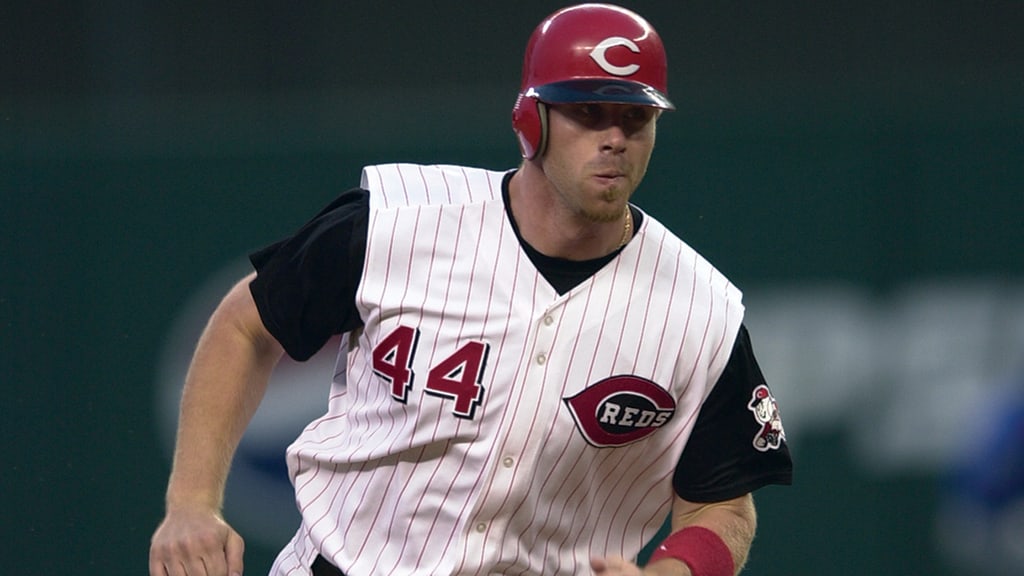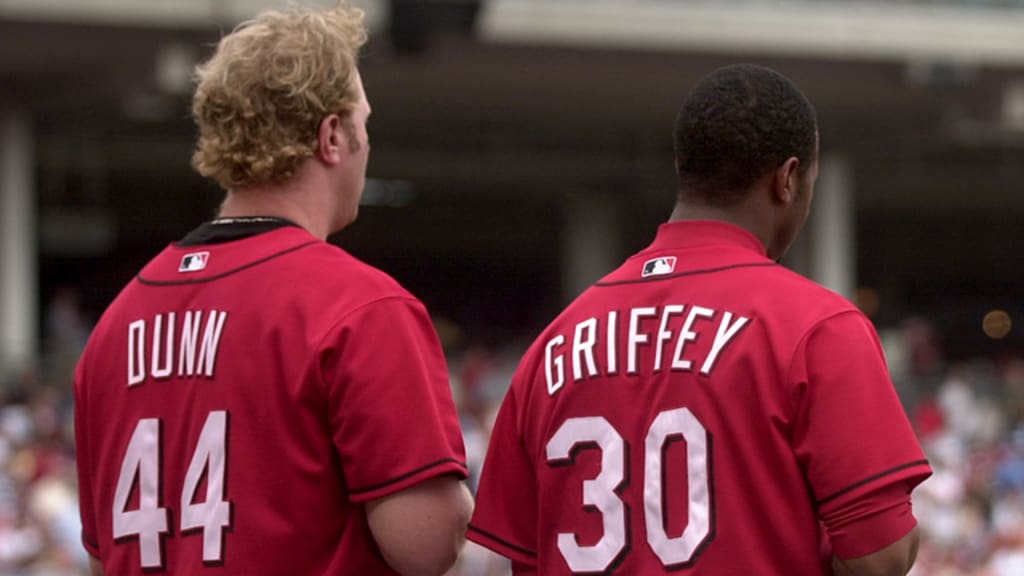
When it comes to looking back at an on-field anniversary for Reds Hall of Famer Adam Dunn, the assumption would be that our trip down memory lane would involve a home run.
And why wouldn’t it? The slugger cleared the fence 462 times in his career, 270 of which came in a Reds uniform (fifth-most in franchise history). There were some especially memorable ones, including the walk-off grand slam against Cleveland in 2006 and the 535-foot blast in '04 that remains the longest ball ever hit at Great American Ball Park.
But today, 18 years later, we remember the “Big Donkey” for his wheels and his strength. On Sept. 10, 2004, the big Texan took home as part of a double steal, barreling over Milwaukee Brewers catcher Mark Johnson in the process.
At the time, the Reds led the Brewers, 5-2, with one out and two runners on base. Austin Kearns was at first, Dunn was at third and Wily Mo Pena was at the plate. With Kearns running, Pena swung through a pitch from pitcher Wes Obermueller and Johnson fired the ball to second to try to nab Kearns. Seeing Dunn take off from third, second baseman Bill Hall shifted his attention to saving a run and rifled the ball right back to home.
What happened next is a play that is all but extinct from baseball today. In fact, it would probably be called targeting in the NFL. Dunn lowered his shoulder just before home plate and delivered a blow to Johnson. The ball went flying, Dunn trotted back over to tap home plate, and the Reds took a 6-2 lead.
This play stands out for several reasons. First, it was a heck of a collision. And it was a collision that baseball fans won’t see much of these days. With the new rules implemented for player safety, catchers cannot impede a runner’s path to the plate, and runners cannot deviate from their direct path to initiate contact with the catcher.
At the time, Dunn simply used his size advantage whenever he could. Watching baseball today, he’s not so sure what players are expected to do in these situations.
“It’s kind of like all these new rules in football,” Dunn said. “I don’t know how you train yourself as a runner -- some of these plays are bang-bang. I don’t know what I would do. If a guy comes up the line, what do you do? I was a freight train not a Ferrari. I would probably be in a bind nowadays.”
Second, most fans wouldn’t expect Dunn to be involved in a double steal. However, Dunn was only two seasons removed from a 19-steal season. Despite his size, No. 44 could also move.
“I had some speed early on for sure,” Dunn said. “I was in football shape when I got there, so I could still run a little bit. But then it changed once you had [Ken Griffey] Jr. and Sean [Casey], guys who could drive me in all the time.”

Third, Dunn would get to fall back on his football roots only a couple times a season at most, so he made it count. A standout quarterback in high school and member of the University of Texas football team before turning his focus to baseball, Dunn never hesitated to use his 6-foot-6 frame to legally lay the lumber on whatever unfortunate soul stood in his path.
“I never slid at home, ever, in my entire life,” he said. “It’s one of those plays that there’s not very many of them over the course of the year -- you’d think there would a lot more, but there’s not. I always thought if there was play at the plate they would have to make a pretty big decision whether to stay there and try to block the plate and catch it. I just figured I’d take my chances running through him and see what happens.”
What usually happened was exactly what happened to Johnson. While the catcher might still be seeing stars from the hit, Dunn doesn’t even remember it. A quick online search will yield results of several home plate encounters Dunn was involved in, so it’s understandable he doesn’t remember them all. He did recall one in 2001 against San Diego involving Padres catcher Wiki Gonzalez (“That was a really, really, really, really, really, good one.”). He also referenced a not-so-pleasant collision in 2007 against San Francisco that required him to get surgery the following day.
There were many others over the course of his 14-year career. And as violent as some of them appeared, there was never any malicious intent. During an era when these plays were part of the game, it was simply a player using his natural advantage to try to get his team a run.
“You’re not out there trying to hurt him, but you aren’t trying to go out of their way either,” Dunn said. “Catchers are tough, that was part of their job description back then. I can think of a few of them that were and still are some really good buddies of mine. But it’s just one of those where I would rather take my chances of scoring running through somebody than trying to make some miraculous slide around someone and they drop a knee and I’m out.”
While Reds fans will always appreciate Dunn as a power hitter, on this day we celebrate Dunn as a power runner.